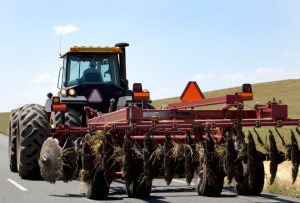You’re driving down a two lane highway, flying along at 55 mph and then you see it—the flashing lights, the giant tires—what kind of a tractor is that? You want to pass, but that thing is huge! Whatever happened to the skinny, little tractor with the triangle on the back, the one that could almost ride on the shoulder? Do farmers really need these machines? And why have they gotten to be so big? Is bigger really better?
It turns out that bigger is actually better for many reasons—from fuel economy to worker safety. And farm machinery, like other technologies, has evolved over time to improve the quality of life for the farmer, the farm workers and the land they care for. But many people like to think nostalgically about those nice, little tractors where the farmer is out in the open air, better yet why not use horses, isn’t that more natural? But think about it, would you want to your dentist to use technology from the 1950s?
Probably not, so what are these new advancements and how do they impact farming. To start with, new equipment is safer for the operator. From the outside, the cab on a tractor looks pretty simple, but it is far more than you might think. New tractors have integrated frames that provide roll-over protection in case of an accident. Cabs are also equipped with sophisticated computer systems that let the operator perform tricky equipment adjustments, which were once the cause of so many tragic accidents. Sophisticated in-cab filtration systems reduce dust particles from entering the cab and other advancements in ergonomics (many of these originated in the office environment) prevent repetitive injuries like carpel tunnel. A funny twist on these advancements is that some are actually frustrating the farmers. The engines run so quietly now that some farmers complain that they can hardly tell if it’s running while idling—sometimes forgetting to shut it off!
As horsepower has increased, so has fuel efficiency and emission reduction. Just like when we consumers upgrade cars to become more fuel efficient, farmers upgrade their tractors to use less fuel and reduce their environmental footprint. Stringent new emissions standards are required by Environmental Protection Agency rules on all new farm equipment. They require a 90% reduction in particulate matter (smoke) and a 50% reduction in oxides of nitrogen (also called smog) compared to older models of tractors. These new engines burn cleaner, are basically smoke-free and are greatly reduce carbon emissions.
Other advancements in farm machinery include using modern technologies like Global Positioning Systems (GPS). GPS systems, similar to the ones you use in your own cars, allow farmers to use the land more efficiently and maximize crop space, ultimately allowing farmers to produce more quality food with less space. The efficiencies translate into using less fertilizer that is applied with greater precision resulting in less risk for leaching and more accurate placement of crop protectants which are more effective and easier on the environment. GPS also gives the operator accurate information so they can cross fields in less passes, which uses less fuel, reduces the carbon footprint and is beneficial to the production system by limiting soil compaction and helping maintain soil viability. GPS is indeed a technological wonder that now even contributes to the longevity and wellbeing of the operators who no longer have to steer these large, self-steering machines across the field, but simply turn them around at the ends!
Ultimately, as productivity on the farm increases, so do the savings to the consumer. Productivity is a direct result of improved technologies in farm equipment—from horsepower to computer power. So next time you end up behind a lumbering giant, just be patient….our food supply depends on them.

Written by newfamilyfarm
Leave a comment